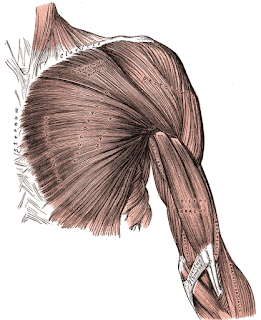
Bicep Muscle

Tricep Muscle
For some time now we’ve been suggesting that you add “isometric muscle contraction” to your poses to enhance both strength building and stretching. I, myself, have been experimenting with it quite a bit in my practice, and have noticed some dramatic results. But since we’ve never really explained much about what we meant by that or how to put it into practice, I’ve decided that today I’m going to go into detail about both the benefits of this technique and the best ways to practice it so you, too, can give it a try.Why Do It Stretching. When you are stretching a particular muscle, consciously activating the agonist muscle (the opposite muscle to the one you’re stretching) will cause the muscle you are stretching to release (though reciprocal inhibition). For example, if you are stretching the your back thigh muscles (hamstrings), activating your front thigh muscles (quadriceps) will release your back thigh muscles, allowing you to increase the hamstring stretch. Bone Strengthening. Although a weight-bearing pose on its own will strengthen bones, if you consciously contract the muscles holding you up by firming them toward the bones, you will enhance the bone strengthening effects of the pose. For example, if you’re standing in Tree pose (Vrksasana), firming your leg muscles will enhance bone building in the standing leg. Muscle Strengthening. As you work in strength building poses, you can strengthen more than just the obviously active muscles by consciously contracting other muscles as you work in the pose. For example, as you hold you arms out to the sides in Warrior 2 (Virabradrasana 2), you can activate your triceps as well as your biceps to increase all-around arm strength. Joint Safety. For people with joint problems, such as arthritis, consciously firming the muscles that support a joint will help protect the joint from strain or wear and tear. For example, if you have knee arthritis, firming the muscles on all sides of your thighs in Extended Side Angle pose (Utthita Parsvakonasana) will help support your knees. And for people who are overly flexible and can bend easily into deep forward bends and backbends, consciously activating the muscles that are supporting you in the pose will prevent you from hanging from your joints, which can cause injury. For example, instead of passively dropping into pose where you bend backward or forward from the hips, such as Camel pose (Ustrasana) and Standing Forward Bend, (Uttanasana) you can protect your hip joints by activating your upper thigh and lower buttock muscles. How to Do It To achieve the benefits I’ve described, you should contract your muscles gently rather than strongly. Strongly contracting a muscle shortens the muscle, which seems to prevent you from moving as freely in the pose. On the other hand, gently firming a muscle toward the bone provides muscular support without interfering with movement. If you’re not used to working this way, it may take some practice. Take it in two steps (thank you, Donald!):
- Consciously relax the muscle, allowing it to lengthen.
- Gently firm the muscle toward the bone.
Another technique I just learned about is that if you are targeting a particular muscle, you can contract the muscle you want to stretch BEFORE you go into the pose. For example, if you want to stretch tight hamstring muscles, you could practice Locust pose (Salabasana) to contract the muscles just before practicing Standing Forward Bend (Uttanasana).
Strength Building. If you are practicing a strength-building pose, rather than contracting only the most obviously active muscle, firm all the surrounding muscles around the bone as well. For example, in Downward-Facing Dog pose (Adho Mukha Svanasana), firm all your arm muscles and shoulder muscles toward the bone. When you want to strengthen your hip area, in a standing pose, for example, you can slowly engage the muscles all around your hip joints, ensuring that this action does not pull you out of good alignment. Joint Safety. For joint safety, you want to emphasize strength and stability rather than promoting more flexibility. So practice as you would for increasing bone or muscle strength by firming the muscles that support your joints. For example, to protect your front knee in Warrior 2 pose, you might shorten the distance between your feet so you are not bending your front knee through such a deep range of motion, and then, when your knee is positioned over your ankle joint, focus on firming the muscles on all sides of the knee joint toward the bone. If you decide to experiment with any of these techniques, either in your home practice or in a class you're teaching, please let me know how it goes!
Subscribe to Yoga for Healthy Aging by Email ° Follow Yoga for Healthy Aging on Facebook ° Join this site with Google Friend Connect

